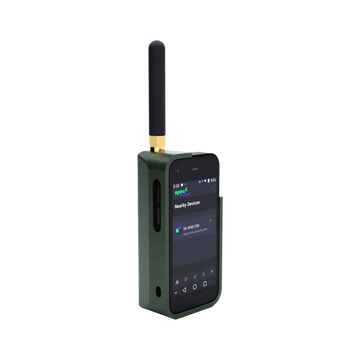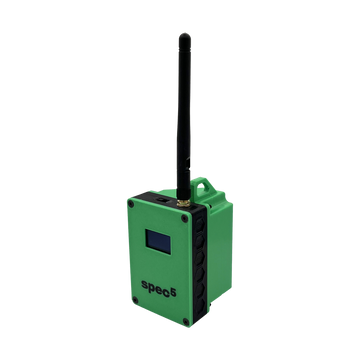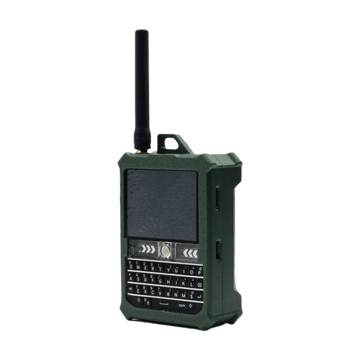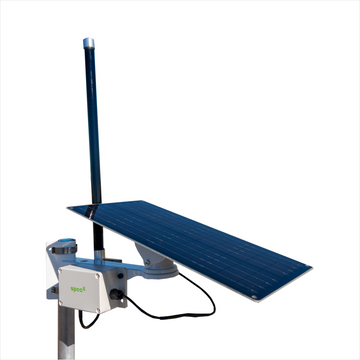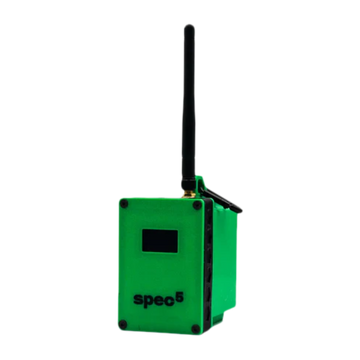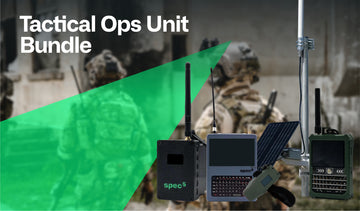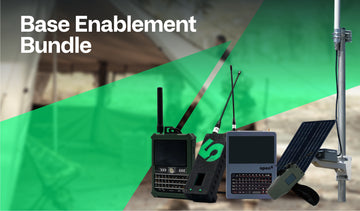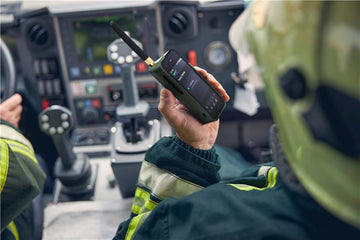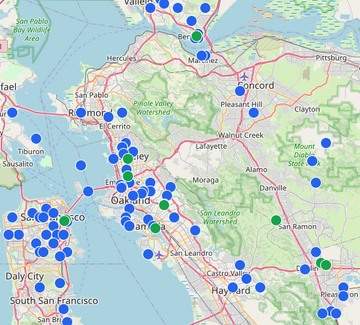Executive Summary
The emergence of modular mesh networking solutions marks a significant evolution in field communications technology. This white paper examines how customizable platforms centered around SpecFive's versatile product line—including the Relay, Spectre, Pulse Pack, Trekker Bravo, Nomad, and Beacon—create unprecedented deployment flexibility across diverse operational environments. By enabling organizations to configure precisely the capabilities they need—without investing in unnecessary components—this modular ecosystem dramatically reduces total ownership costs while increasing adaptability to changing mission requirements.
Through detailed analysis of implementation across agricultural, logistics, maritime, and critical infrastructure applications, we demonstrate how mix-and-match hardware approaches yield significant operational advantages over traditional fixed-configuration systems. Case studies reveal how early adopters have achieved 40-60% cost savings while maintaining greater field reliability through the strategic deployment of purpose-specific configurations. Additional benefits emerge from the thoughtful integration of voice capabilities alongside data mesh networks, creating comprehensive communication solutions that leverage appropriate frequencies for different operational needs.
1. Introduction to Modular Architecture
1.1 The Modular Imperative
Traditional communications hardware has historically followed a monolithic design philosophy—devices with fixed capabilities manufactured to serve generalized use cases. This approach inevitably leads to compromises: organizations either invest in excessive capabilities they rarely utilize or accept functional limitations that constrain operational effectiveness.
The modular mesh network ecosystem rejects this paradigm, instead offering:
- Component-level selection of capabilities based on specific operational needs
- Field-configurable systems that adapt to changing mission requirements
- Incremental upgrade paths that preserve initial infrastructure investments
- Specialized configurations optimized for specific deployment environments
- Multi-modal communications combining voice and data where appropriate
1.2 Limitations of Fixed-Configuration Approaches
Fixed-configuration mesh networking devices present several operational challenges:
|
Challenge |
Operational Impact |
|
Overprovisioning |
Organizations pay for unused capabilities, increasing per-node costs |
|
Underprovisioning |
Field teams face functional limitations that impact mission effectiveness |
|
Replacement Cycles |
Entire units must be replaced to gain new capabilities |
|
Environmental Constraints |
Devices designed for general use may fail in specialized environments |
|
Repair Complexity |
Failure of any component typically requires complete unit replacement |
|
Communication Silos |
Voice and data systems often operate independently, creating coordination challenges |
1.3 The Modular Mesh Value Proposition
The modular approach delivers four core advantages:
Cost Optimization: Organizations purchase only the components necessary for their specific operational requirements, with entry-level configurations starting at 40% lower cost than comparable fixed-configuration systems.
Mission-Specific Customization: Field teams deploy precisely the capabilities needed for each operational environment, from lightweight tracking-only nodes to comprehensive communication platforms.
Incremental Evolution: Systems grow with organizational needs through component-level upgrades rather than wholesale replacements.
Field Maintainability: Individual components can be replaced in the field without specialized tools or technical expertise.
Comprehensive Communications: Integration of voice and data capabilities ensures teams have appropriate tools for every communication need.
2. Core Modular Components
2.1 Relay: The High-Performance Network Backbone
The Relay serves as the backbone for extensive mesh network deployments, providing exceptional range and reliability:
Technical Specifications:
- High-power LoRa transceiver 915 MHz for long-range, low-power communication
- Ruggedized IP67 enclosure for all-weather operation
- Dual 18650 battery system and Solar charging compatibility for indefinite deployment
- Designed for permanent pole, tower, or rooftop installation
- External IP67 antenna supports range optimization up to 10+ miles (rural, LOS)
The Relay's exceptional range makes it ideal for establishing the core infrastructure of mesh networks spanning large geographical areas or challenging terrain.
2.2 Spectre: The Tactical Communication Hub
The Spectre operates on LoRa mesh technology does not depend on cellular network:
Key Features:
- Android 9.0 with 2GB RAM and 16GB storage
- Dual-SIM support with GPS, Wi-Fi, and hotspot capability
- 2.5” HD touchscreen, rear/front cameras, MTK processor
- 915 MHz LoRa transceiver (SX1262) powered by independent battery
- Urban range: 1–3 miles | Rural range: 3–5 miles
- Dual battery system: 1000mAh (Android) + 1200mAh (LoRa)
- Rugged PETG casing in Black, Tactical Green, or Desert Sand
- Preloaded with Meshtastic and custom Spec5 mesh coordination apps
Whether you're coordinating field operations, navigating unfamiliar terrain, or simply staying connected off-grid, the Spectre delivers plug-and-play mesh communication with the familiarity of Android—no setup required.
2.3 Pulse Pack: The Wearable Network Extension
The Pulse Pack combines LoRa mesh messaging with FRS voice transmission, making it perfect for teams operating in remote or off-grid environments.
Design Elements:
- Dual-mode communication: FRS voice + LoRa text
- Real-time GPS tracking and location sharing
- 1800mAh battery with 8 hrs active / 24 hrs standby runtime
- Urban range: 1–3 miles | Rural range: 3–5 miles
- Durable PETG casing
- Compact, wearable form factor (145g) with belt clip and lanyard
- Complete bundle: 2 radios, dual charger, earpieces, clips, and accessories
- No license or subscription required
The Pulse Pack's lightweight design makes it ideal for personnel who need to maintain mesh network connectivity without the burden of larger communication devices.
2.4 Trekker Bravo: The Environmental Interface
The Trekker Bravo is a rugged, GPS-enabled LoRa mesh communicator.
Technical Capabilities:
- Meshtastic-enabled for seamless peer-to-peer mesh networking
- Display & Interface: No screen; app-based control via Bluetooth pairing with the phone
- 915 MHz LoRa (SX1262) transceiver for extended range
- GPS integration for location sharing and team tracking
- 2500mAh internal battery: 8 hrs active / 24 hrs standby
- Compact form: 5.8 oz, rugged PETG shell
- Real-world range: 1–3 miles urban, 3–5 miles rural
- Ready to use right out of the box — no setup required
The SpecFive Trekker Bravo is a rugged, GPS-enabled LoRa mesh communicator, ready out of the box to keep adventurers and preppers connected far beyond cellular coverage.
2.5 Nomad: The Expedition Communication Platform
The Nomad delivers comprehensive communication capabilities for remote expeditions and extended field operations:
Key Specifications:
- 915 MHz LoRa (SX1262) module with Meshtastic support
- Built-in keyboard for text input and standalone use
- 10,000 mAh rechargeable battery for multi-day operation
- Linux ARM computer for scripting, BBS systems, and network tools
- LAN and USB ports for bridging, expansion, or development
- Rugged housing built for demanding outdoor environments
- GPIO headers and expansion pins for advanced customization
- Supports Wi-Fi ↔ LoRa bridging and Python network automation
The Spec5 Nomad is a rugged, Linux-powered LoRa mesh communicator with a built-in keyboard, 10,000 mAh battery, and full offline networking capabilities for developers and field teams operating beyond infrastructure.
2.6 Beacon: The Autonomous Network Node
The Beacon works as both a handheld communicator and a reliable off-grid relay hub.
- Radio Module: High-efficiency LoRa 915 MHz (SX1262)
- Processor: 32-bit ARM Cortex-M4
- Memory: 256 Kb Flash, 1 Mb RAM
- Battery: 2x non-removable 18650 batteries @ 2500mAh each (total: 5000mAh)
- Runtime: Multi-day battery life on a single charge
- Solar Charging: Extends life by 1–3 days depending on sun exposure
- Form Factor: Can be used as handheld OR stationary mesh repeater Compact (90 x 65 x 60 mm), lightweight (180g)
- Enclosure: PETG – rugged, heat-resistant, chemically stable
- Antenna: External 915 MHz LoRa + GPS ceramic antenna
- Range: ~1–3 miles (urban), ~3–5 miles (rural)
- Meshtastic Ready: Pre-flashed, plug-and-play setup
- Use Cases: Base camp hub, mobile field unit, mesh repeater, emergency kit essential
The Beacon's self-sufficient design makes it ideal for establishing persistent network coverage in remote areas or creating vehicle-tracking networks with minimal maintenance requirements.
2.7 Component Compatibility Matrix
All components within the ecosystem adhere to standardized interfaces, ensuring cross-compatibility:
|
Component |
Data Mesh |
Solar Compatible |
Vehicle Mountable |
Deployment Duration |
|
Relay |
Extended Range |
Yes |
Yes |
Months+ (with solar) |
|
Spectre |
Standard |
No |
Yes |
- |
|
Pulse Pack |
Standard |
No |
No |
- |
|
Trekker Bravo |
Standard |
No |
Yes |
- |
|
Nomad |
Standard |
No |
Yes |
- |
|
Beacon |
Extended Ranger |
Built-in |
Yes |
Indefinite |
3. Industry Vertical Applications
3.1 Agricultural Implementation
Modern agricultural operations demand distributed, off-grid communication and location sharing across wide areas — an ideal fit for LoRa-based mesh networks powered by Spec5 devices.
Typical Configuration:
- Central Nodes: Spec5 Relay or Beacon — solar-powered and ideal for mounting at elevated points to cover large acreage
- Mobile Field Units: Trekker Bravo and Spectre — GPS-enabled devices for field workers, vehicles, or roaming staff
- Voice Communication: Pulse Pack — FRS + LoRa radios for quick audio coordination
-
Network Gateway or Developer Control: Nomad — a Linux-powered node for scripting, Wi-Fi bridging, or potential IoT integration
Use Case Benefits:
- Real-time team coordination across large fields without cellular service
- GPS location sharing for field workers, equipment, or livestock
- Mesh-based redundancy for reliable communication even in remote zones
- Potential for future integration with sensors and automation via Nomad’s GPIO pins
- Zero subscription or licensing costs; full offline functionality
Compared to cellular-based systems, a LoRa mesh setup can reduce total implementation costs by up to 60%, with no recurring data fees.
3.2 Logistics and Supply Chain
LoRa-based mesh networks enable logistics and supply chain operators to monitor and coordinate assets without dependency on traditional cellular or Wi-Fi infrastructure — especially in yards, warehouses, and field depots.
Typical Configuration:
- Warehouse Nodes: Relay units with high-gain antennas for coverage across loading zones
- Yard / Perimeter Nodes: Beacon or Relay units deployed at fixed points to extend range
- Vehicle / Equipment Tracking: Trekker Bravo or Pulse units for GPS-based location sharing
- Personnel Communication: Pulse Pack or Spectre for team messaging and mobile coordination
-
Developer Control: Nomad for future integrations (e.g., Python scripts, GPIO sensors)
Use Case Benefits:
- Real-time vehicle or equipment tracking across facilities
- GPS-based coordination between staff and mobile units
- LoRa-based communication mesh that works without Wi-Fi or SIM cards
- Zero subscription fees and offline-first architecture
- Flexible deployment for temporary events or evolving warehouse layouts
Unlike cellular-based systems, a Spec5-powered LoRa mesh network can significantly lower operating costs and improve coverage in hard-to-wire areas, with ROI driven by reduced delays, improved coordination, and increased situational awareness.
3.3 Maritime Operations (Corrected)
Marine environments present unique challenges for communication and tracking — including saltwater exposure, lack of cellular coverage, and vessel mobility. Spec5’s LoRa-based mesh ecosystem provides a flexible, low-cost alternative to traditional marine radio infrastructure.
Typical Configuration:
- Vessel Units: Trekker Bravo or Spectre — GPS-enabled mobile nodes for boats, barges, and small vessels
- Dockside Nodes: Spec5 Relay — solar-powered mesh repeaters mounted with high-gain antennas
- Offshore Monitoring or Buoy-Based Mesh Extension: Nomad for sensor integration and scriptable control
-
Crew Communication: Pulse Pack for short-range voice and LoRa text messaging on deck or at port
Use Case Benefits:
- GPS-based vessel tracking and location reporting
- Shore-to-ship communication via LoRa mesh without satellite or SIM
- Custom sensor integration for temperature, salinity, or location-based alerts (Nomad with GPIO)
- Mesh-based coordination between vessels and shore teams
- Fully offline-capable with zero subscription or airtime costs
Compared to dedicated marine systems, Spec5’s modular approach offers up to 50% lower total cost of deployment while enabling more adaptable communication across fleets, docks, and nearshore aquaculture sites.
3.4 Critical Infrastructure (Corrected)
Critical infrastructure — including power stations, water plants, data centers, and industrial sites — requires resilient, redundant communication systems to operate during outages or disasters. Spec5 mesh networks provide flexible, low-power alternatives to traditional monitoring systems that rely on cellular or Wi-Fi coverage.
Typical Configuration:
- Perimeter Coverage: Relay nodes with high-gain antennas, solar or mains powered
- Mobile Staff Tracking: Trekker Bravo or Spectre devices with built-in GPS for personnel location
-
Onsite Response & Voice Communication: Pulse Pack devices offering short-range voice and LoRa text communication
-
Advanced Sensor Integration: Nomad for custom deployments requiring GPIO-based environmental or tamper sensors
Use Case Benefits:
- GPS-based personnel tracking in high-risk zones
- Decentralized communication in case of grid/cellular failure
- Integration with 3rd-party environmental sensors (via Nomad) for flood/fire alerts
- Tamper alerts and network extension using modular LoRa relays
- No recurring fees, SIM cards, or dependencies on public networks
Spec5’s modular platform adds a self-contained layer of situational awareness to infrastructure sites—ideal for disaster response, cyber-physical security, or remote monitoring in areas where uptime is critical.
4. Case Studies
4.1 Agricultural Cooperative: Seasonal LoRa Mesh Deployment
Organization: Midwest Growers Cooperative (250 members, 120,000 acres)
Challenge: Build a flexible, low-cost field communication and location tracking network that can adapt to seasonal farm needs, without relying on cellular infrastructure or fixed sensors.
Implementation:
- Core Network: 8 Spec5 Relay nodes, solar-powered and mounted at high points to cover distributed acreage
- Personnel & Equipment Tracking: 35 Trekker Bravo units deployed across tractors, harvesters, and roaming crews to share GPS-based locations
- Field Communication: 12 Spectre devices used by supervisors for text-based updates and coordination
-
Mesh Integrity & Redundancy: Seasonal Beacon nodes placed at remote perimeters to extend range and bridge communication gaps
Seasonal Adjustments:
- Spring: Additional field nodes added to monitor seed team locations
- Summer: Network density increased for active coordination across large irrigation zones
- Fall: Beacon placements optimized for harvest convoy visibility
-
Winter: Minimal relay nodes left operational for year-round system maintenance
Results:
- 65% cost reduction vs. cellular-based sensor proposals
- Modular deployment allowed reallocation of devices per season
- Equipment-based GPS tracking helped reduce idle time and optimized dispatch
- System-wide communication remained functional even during signal outages or storms
4.2 Shipping Company: Multi-Environment Monitoring
Organization: TransGlobal Shipping (28 vehicles, 3 warehouses)
Challenge: Build a unified, low-cost asset tracking and communication system that functions seamlessly across warehouses, loading yards, and while in transit — without relying on cellular connectivity or commercial tracking software.
Implementation:
- Warehouse Coordination: 12 Trekker Bravo units used for location tracking of portable assets and roaming personnel
- Yard Coverage: 6 Relay nodes with high-gain antennas deployed at perimeter poles for stable LoRa mesh connectivity
- Voice Communication: 15 Pulse Pack units carried by security and field personnel for voice and text-based coordination
-
Dispatch & Messaging: 8 Spectre devices used by supervisors for text-based command & control over LoRa mesh
Results:
- 48% reduction in costs compared to cellular-based commercial asset tracking systems
- Full visibility of vehicle locations, warehouse movement, and dispatch status without SIM cards
- Voice and text-based comms helped eliminate on-site coordination delays
- Measurable reduction in theft and unauthorized vehicle access due to mesh tracking
- Operational efficiency improved across loading and unloading due to better crew-to-dock communication
4.3 Emergency Management: Rapidly Deployable Mesh Communications
Organization: Western Regional Emergency Management Authority
Challenge: Enable emergency response teams to deploy secure, redundant communications rapidly in disaster scenarios ranging from wildfires and floods to earthquakes and hazmat situations — all without relying on cellular or satellite infrastructure.
Implementation:
Each response team was equipped with a standardized modular kit:
- 2 Relay units to form the backbone of the local mesh network
- 6 Spectre units for text-based coordination between field supervisors and command centers
- 8 Beacon units deployed at fixed points to expand mesh coverage across affected areas
- 12 Pulse Pack units carried by field responders for GPS tracking and short-range voice communication
Results:
- 72% faster setup compared to legacy comms equipment
- Flexible configuration adapted to multiple disaster types (wildfire, flood, quake, hazmat)
- Offline mesh messaging ensured field communication even during network blackouts
- Voice-enabled Pulse Packs eliminated coordination delays
- Nomad units enabled experimental environmental monitoring and custom tactical tools
- The system proved its resilience during a major wildfire response, where teams shifted from perimeter extension to personnel tracking within 15 minutes as the situation changed
5. Implementation Best Practices
5.1 Component Selection Guidelines
Organizations implementing modular mesh systems should use a structured approach to selecting the right mix of devices and configurations for their specific operational needs.
Core Network Planning
- Define the total coverage area and expected node density
- Identify elevated or central points for Relay or Beacon placement
- Establish redundancy requirements to ensure failover capability
- Determine if voice communication is required (supported only by Pulse Pack)
Node Capability Assessment
- Categorize each deployment site by purpose: relay, mobile unit, command, perimeter, etc.
- Identify special needs such as location tracking, text coordination, or sensor integration
- Evaluate power options: solar, vehicle-mounted, mains, or battery-only
- If environmental data collection is required, plan for Nomad deployment with external sensors
Component Selection Process
- Assign the appropriate node for each use case:
- Relay / Beacon for coverage extension
- Trekker Bravo / Spectre for mobile GPS-based coordination
- Pulse Pack for personnel tracking and voice communication
- Nomad for developer-level control or sensor scripting
- Choose accessories: antennas, mounts, solar panels, earpieces, etc.
- Calculate power needs per node (battery life, solar supplementation)
- Define antenna types to ensure strong, reliable links between nodes
A structured assessment process typically yields 3–5 distinct device configurations, each optimized for a specific role within the overall mesh network — enabling reliable, scalable, and cost-efficient deployments.
5.2 Frequency Management Considerations
Effective deployment of a hybrid LoRa mesh system requires deliberate planning around frequency use and communication modalities.
LoRa Mesh Data Networks
- Operate on the unlicensed ISM band (915 MHz in the US)
- Can legally transmit encrypted data
- Offer long-range, low-bandwidth communication ideal for:
- GPS position sharing
- Text-based team coordination
- Sensor data (via Nomad GPIO)
- Mesh design enables resilient, infrastructure-independent communication in rural or disrupted areas
Voice Communication
- FRS (Family Radio Service) — Used in Spec5 Pulse Pack
- License-free in the U.S.
- Limited range (~0.5–1.5 miles depending on terrain)
- Ideal for immediate, short-range team coordination
- Push-to-Talk over Cellular (PoC) – Possible on Spectre using Android apps (e.g., Zello, ATAK)
- Dependent on cellular or Wi-Fi availability
- Not suitable for fully off-grid deployments
- Offers encrypted voice options when configured through secure apps
Integration Strategy
- Reserve FRS voice channels (via Pulse Pack) for real-time or emergency coordination
- Use LoRa mesh (Trekker, Beacon, Spectre, Nomad) for persistent data, location, and alerts
- Configure devices to escalate from silent alerts to voice where appropriate (e.g., hazard threshold triggers)
- Establish protocols defining which data travels via text and which via voice, based on urgency and availability
5.3 Testing Protocols for Custom Configurations
Before field deployment, each unique node configuration should undergo standardized validation to ensure reliability, battery performance, and compatibility with the intended use case.
Minimum Testing Protocol
-
Power Consumption Testing
Measure draw under real-world usage to confirm expected battery duration and solar charging behavior (where applicable) -
Battery Life Validation
Simulate operational conditions (active/standby cycles) to confirm that runtime meets mission requirements for each node type -
Durability & Environmental Exposure Testing
Validate enclosure durability (e.g., PETG impact resistance) and behavior under expected conditions -
LoRa Communication Range Testing
Test each node in urban and rural environments to establish link stability at planned deployment distances -
Sensor Accuracy (Nomad-Only)
When external sensors are attached via the Nomad’s GPIO, verify accuracy and stability under field conditions -
Voice Communication Quality (Pulse Pack Only)
Evaluate FRS voice clarity and range in relevant operational settings such as warehouses, open fields, or obstructed sites -
Failure Mode Analysis
Simulate power failure, node dropout, or network congestion to test recovery protocols and mesh self-healing behavior
Why It Matters:
Documenting the performance of each configuration provides a critical reference point for system optimization, future troubleshooting, and training across operational teams.
5.4 Maintenance Considerations for Field-Modified Systems
Modular mesh networks require ongoing maintenance to ensure reliability across deployments, especially when systems are field-customized or deployed in harsh environments.
Maintenance Best Practices
-
Manual Health Checks & App-Based Diagnostics
Regularly verify node connectivity, battery status, and network presence via the Meshtastic app or dashboard interface -
Planned Battery Replacement Schedule
Replace internal batteries on a predictable cycle (e.g., annually), rather than waiting for end-of-life failures in the field -
Sensor Calibration (Nomad-Only Systems)
For custom deployments using external sensors connected to Nomad’s GPIO, recalibrate sensors periodically based on environmental conditions -
Physical Inspection
Check the mounting and housing integrity of outdoor or mobile nodes (Relays, Beacons) for water ingress, corrosion, or physical wear -
Firmware Update Procedure
Maintain a defined update process with verified firmware images and documented fallback steps in case of failure (manual re-flash recommended) -
Spare Parts & Component Inventory
Maintain backup antennas, cables, power units, and mounting accessories to support quick in-field repairs and node swaps -
Maintenance Structure:
A tiered maintenance model is recommended:
Field personnel perform routine checks, status reporting, and battery swaps
Technical specialists handle firmware updates, diagnostics, sensor tuning, and integration troubleshooting
6. Future Expansion Roadmap
6.1 Upcoming Enhancements
The Spec5 ecosystem continues to evolve, with active development and research expanding the capabilities of modular mesh systems across edge environments.
Near-Term Releases (6–12 months)
- RTK GPS Support: Select models will offer enhanced GPS precision via real-time kinematic (RTK) capabilities
- Expanded Sensor Integration: Support for water quality, temperature, humidity, and other sensors via Nomad’s GPIO interface
- Directional Antenna Modules: Field-alignable directional antennas to extend range and improve link quality
- Fleet Tracking Exploration: Conceptual development of GPS modules with OBD-II integration for logistics use cases
-
Remote Connectivity R&D: Initial R&D into satellite uplink options for ultra-remote mesh relay nodes
Development Pipeline (12–24 months)
- Edge AI Capabilities: Testing AI inference modules on Nomad devices for localized decision-making and pattern detection
- Acoustic Monitoring: Early research into low-power acoustic sensors for wildlife activity or perimeter breach detection
- Encryption Upgrades: Exploration of hardware-based encryption enhancements for regulated sectors
- Software-Defined Radio (SDR): Evaluating future hardware designs for diagnostic and flexible radio configurations
-
Low-Bandwidth Visual Monitoring: Research into low-resolution image capture and transmission over LoRa for static surveillance or wildlife applications
6.2 Backward Compatibility Guarantees
The Spec5 modular ecosystem is designed with long-term reliability and customer investment protection in mind. All system components follow strict compatibility protocols to ensure continuity across hardware generations and deployment scales.
Compatibility Framework
-
Version-Controlled Interfaces
All hardware and firmware interfaces are governed by version-controlled specifications with published standards for cross-device operability. -
Cross-Generational Hardware Support
New modules and accessories are engineered to maintain functional compatibility with previous-generation hardware, minimizing obsolescence. -
Legacy Adapter Availability
When physical connector standards evolve, adapter kits are offered to preserve integration with existing installations. -
Software Compatibility Layers
Firmware updates are designed to support older devices via compatibility layers, ensuring continued performance even as newer models introduce advanced features. -
Open Documentation & APIs
All interface specifications are publicly documented, allowing third-party developers and integrators to build interoperable solutions confidently.
This structured approach ensures that as the Spec5 ecosystem evolves, existing deployments remain stable and usable—protecting your investment while enabling access to future capabilities.
6.3 Community-Developed Extensions
The open architecture of the Spec5 ecosystem has fostered a vibrant and growing community of developers, researchers, and integrators contributing valuable extensions across industry sectors.
Notable Community Contributions
-
Agricultural Sensor Modules
Integrations for leaf wetness, soil pH, and nutrient monitoring—enhancing precision agriculture without the need for centralized infrastructure -
Industrial Monitoring Interfaces
GPIO-driven extensions to monitor temperature, vibration, and process control metrics in factory and remote site environments -
Security Enhancements for Critical Infrastructure
Community-developed alert modules, tamper sensors, and low-power perimeter intrusion detectors for sensitive installations -
Environmental Research Sensors
Plug-ins for collecting localized weather, air quality, and water composition data in field stations and academic studies -
Custom Enclosures for Harsh Deployments
3D-printable and machined designs adapted for underwater, arctic, or high-impact environments
These contributions significantly expand system versatility—often without modifying core hardware or firmware—enabling rapid adaptation to niche and evolving use cases.
6.4 API and Software Extensibility
The Spec5 platform is designed to be as flexible in software as it is in hardware. Its open architecture allows organizations to build highly tailored solutions by extending and integrating system functions through programmable interfaces.
Key Software Capabilities
-
Open API Access
Device-level and system-wide APIs enable real-time data extraction, network configuration, and external control from third-party dashboards and scripts -
Plugin-Friendly Architecture (Nomad Platform)
The Linux-based Nomad supports modular Python scripts and custom utilities, enabling field-deployable logic and application extensions -
Enterprise Integration Hooks
Bridge LoRa mesh data into enterprise tools (e.g., SCADA, ATAK, GIS systems) via middleware or network gateways -
Data Normalization Across Inputs
Consistent formatting of multi-source sensor data (where supported) allows for unified processing, analytics, and logging -
Rule-Based Automation Engine (Experimental)
Configure simple logic rules (e.g., "if GPS exit geofence, send alert") for autonomous field behavior — in progress for Nomad-based deployments
By combining low-power hardware with a programmable backend, the Spec5 ecosystem empowers teams to create end-to-end operational systems — from tactical communications to sensor-driven automation — without being locked into rigid commercial platforms.
7. Conclusion: The Ecosystem Advantage
SpecFive’s modular mesh network ecosystem marks a strategic shift in field communications—replacing rigid, monolithic systems with flexible, purpose-built configurations that evolve alongside organizational needs.
-
Cost Optimization
Targeted deployment of only required capabilities—rather than all-in-one systems—lowers upfront and recurring costs by 40–60%, eliminating unused features and reducing infrastructure dependencies. -
Operational Resilience
Component-level serviceability and hot-swappable nodes reduce downtime, simplify field repairs, and extend system life without costly overhauls. -
Future-Proofing
Incremental upgrade paths and backward-compatible hardware ensure that early investments remain viable as new technologies, sensors, and capabilities are added to the ecosystem. -
Performance Optimization
Purpose-configured devices (e.g., GPS tracking, voice, sensor-driven logic) outperform generic solutions in mission-specific roles—whether in agriculture, logistics, emergency response, or industrial monitoring. -
Comprehensive Communication
Integrated support for both voice (via FRS) and encrypted LoRa data messaging ensures field teams have the right tools for real-time coordination and long-range information sharing—even in disconnected or degraded environments.
Organizations across sectors—agriculture, emergency services, logistics, maritime, and critical infrastructure—are already realizing the benefits of SpecFive’s modular approach through reduced capital expenditure, increased field efficiency, and improved system adaptability.
As communication needs continue to evolve, flexibility, interoperability, and resilience will define successful infrastructure. Modular mesh networks offer a sustainable path forward—empowering teams to scale, reconfigure, and innovate without abandoning existing investments.
To explore implementation strategies, request a demo, or access full technical specifications, visit specfive.com or contact our solutions team.

